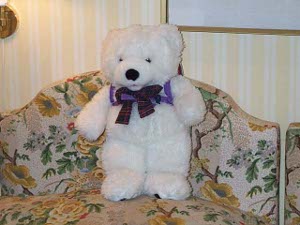 Train cars on the ferry
Train cars on the ferry
The messages on our train from Hamburg to Copenhagen were in German, Danish, and English until we crossed the border, and then in Danish, German and English the rest of the way in. The conductor enjoyed practicing his English.
It was a small train, consisting of an engine and three cars. The car diagram on the platform in Hamburg was incomprehensible. First of all, the cars were shown divided into two, so we thought there would be six cars, each half as long as an ordinary railroad car. Then there were four numbers - cars 20, 21, 22, and 23 - given to the six half-cars; two of the six were unnumbered. Four of the six half-cars were shown as second class (dark green) and the other two were shown as half second class and half first class.
Possibly the errors in the diagram had to do with translating from Danish into German, because it was a lovely Danish train, with three nice cars, split into an odd mixture of first, business, and second class. We had two facing window seats with a table between, and agreed it was the most comfortable train we'd ridden so far.
Somewhere north of Luebeck a slender man in his thirties, wearing a black turtle neck and a grey suit coat, asked the Americans in the seat next to us for their passports, and then asked some questions about their itineraries and their luggage. He seemed satisfied with the answers.
A little later, the American made a point for thanking the conductor for delivering the announcements in German, as he was brought up in Anaheim. Ana, heim, he explained. The conductor smiled.
 Train cars on the ferry
Train cars on the ferry
There was a little galley on board, like an airplane, and a woman drove a cart up and down the aisles of the train with food for sale. We had had our coffee and Danish at the train station and were content.
Then, at the German ferry station, two uniformed agents, a man and a woman, boarded our train, and asked in German for everyone's passports.
The ferry was a big number, which carried people and cars and trucks and trains from Germany to Denmark. They just drove the train onto a track on the ferry (pretty good engineering).
After announcing on the loudspeaker (in three languages) that it would take us 45 minutes to cross (he said 44 in German and Danish) and offering the restaurant car and duty-free shopping on board the ferry, the conductor came into all the cars and encouraged everyone to use the duty-free shop.
We were reluctant to leave our belongings unprotected on the train, whose doors were left open, so we took turns wandering around the ferry. We couldn't see either shore, but made out a few passing ships in the fog. The ferry was very modern, and a lot of the locals were taking advantage of the duty-free to purchase a few bottles of this and that. People were eating and relaxing in a number of passenger lounges; there was a special section for truck drivers.
We returned to the train, which drove off the ferry and then stopped at the Danish ferry station, where two uniformed agents boarded the train and asked in Danish for everyone's passports.
This was more passport control than we'd seen on our entire trip to Europe so far; a couple of years ago we had driven a car from Germany to Denmark and not shown our passports. Possibly the German and Danish officials are bristling over the Danes' recent vote not to join the common currency, the Euro, just yet.
The train made three more stops, the train attendant made a few more  Doesn't like her fur wet
passes with the cart, and we reached Copenhagen before noon. The TV weather report the night before in Hamburg showed a big sun over Copenhagen, so we were not expecting the clouds which turned to rain in the late afternoon.
Doesn't like her fur wet
passes with the cart, and we reached Copenhagen before noon. The TV weather report the night before in Hamburg showed a big sun over Copenhagen, so we were not expecting the clouds which turned to rain in the late afternoon.
After buying our Copenhagen guide book we learned that the Danes are engaged on a project to connect Copenhagen by road and rail to Germany and Sweden, through a series of causeways and tunnels; the whole project should be completed in five years.
We took an afternoon walk down the Stroget. In 1962 this main shopping street was closed to vehicles, and it was absolutely thronged with people today. There were all kinds of street entertainers: mimes, musicians, comedians, and balloon twisters. There were wonderful shops, lots of Danish modern design, and all kinds of food (Danish waffles made fresh in a stand on the street looked enticing). The people seemed friendly, happy, and polite; even in the rain we enjoyed our stroll.
Cuddles likes the bed in the hotel room, but she did not go out for a walk in the rain because she hates to get her fur wet.